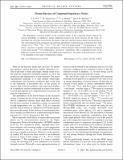Fission Barriers of Compound Superheavy Nuclei
Author(s)
Sheikh, J. A.; Nazarewicz, W.; Kerman, Arthur Kent; Pei, J. C.
DownloadPei-2009-Fission Barriers of.pdf (356.7Kb)
PUBLISHER_POLICY
Publisher Policy
Article is made available in accordance with the publisher's policy and may be subject to US copyright law. Please refer to the publisher's site for terms of use.
Terms of use
Metadata
Show full item recordAbstract
The dependence of fission barriers on the excitation energy of the compound nucleus impacts the survival probability of superheavy nuclei synthesized in heavy-ion fusion reactions. In this work, we investigate the isentropic fission barriers by means of the self-consistent nuclear density functional theory. The relationship between isothermal and isentropic descriptions is demonstrated. Calculations have been carried out for [superscript 264]Fm, [superscript 272]Ds, [superscript 278]112, [superscript 292]114, and [superscript 312]124. For nuclei around 278112 produced in “cold-fusion” reactions, we predict a more rapid decrease of fission barriers with excitation energy as compared to the nuclei around [superscript 292]114 synthesized in “hot-fusion” experiments. This is explained in terms of the difference between the ground-state and saddle-point temperatures. The effect of the particle gas is found to be negligible in the range of temperatures studied.
Date issued
2009-05Department
Massachusetts Institute of Technology. Center for Theoretical Physics; Massachusetts Institute of Technology. Department of PhysicsJournal
Physical Review Letters
Publisher
American Physical Society
Citation
Pei, J. C. et al. “Fission Barriers of Compound Superheavy Nuclei.” Physical Review Letters 102.19 (2009): 192501. (C) 2010 The American Physical Society.
Version: Final published version
ISSN
0031-9007